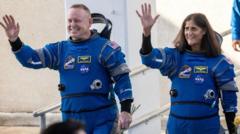When astronauts Suni Williams and Butch Wilmore approached the International Space Station (ISS) last year, they faced an unexpected challenge: their Boeing Starliner capsule's thrusters were failing. As they attempted to dock, apprehension filled the air. If they couldn't dock, they were uncertain if they could ever return to Earth. "Docking was imperative," Wilmore said in an interview two months post-return. "If we weren't able to dock, would we be able to make it back? We didn't know."
Originally embarking on an eight-day test flight, their mission extended to nearly ten months. The immediate challenge was a successful docking at the ISS, which they managed with critical assistance from Mission Control that helped restart the capsule's thrusters. The anxieties associated with possibly not returning home were real, yet both astronauts remained focused on problem-solving instead of vocalizing worst-case scenarios. Williams noted, “You sort of read each other's minds during failures… we quickly shifted our focus to solutions."
The pair's journey began in June 2024 during the inaugural crewed test flight of the Starliner spacecraft, developed by Boeing. However, technical problems led to the decision to avoid using the Starliner for their return. Instead, they were to ride back on a SpaceX capsule. Despite this adjustment, Boeing maintained that the Starliner was still a safe spacecraft, a fact later confirmed when it returned uncrewed in September 2024.
Throughout their time at the ISS, which the media referred to as being "stranded," they felt secure in their situation as the space station was always equipped with spacecraft that could serve as lifeboats in emergencies. Despite the longer-than-expected stay, Williams reflected a sense of community, stating, “We knew nobody was going to just let us down… everyone had our backs.”
Complicating their situation, the pair became subjects of political discourse when former President Donald Trump blamed the Biden administration for their predicament. Nevertheless, they chose to remain focused on their mission and commented on the inherent difficulties of human spaceflight. “We understand spaceflight is hard,” Wilmore remarked.
Now back on Earth, both astronauts reported feeling fit, crediting their rigorous exercise routine during their zero-gravity stay. Wilmore noted he performed daily weight training, resulting in him returning "stronger than ever." Williams also mentioned running a marathon on a treadmill in space but noted the adjustments needed to landing back on Earth were not without challenges.
Post-return, they continued collaborating with NASA and Boeing to address the spacecraft's malfunction issues, expressing optimism about flying the Starliner again once the problems are resolved. “It’s a very capable spacecraft,” Williams affirmed. “It has unique capabilities… great for future astronauts to fly.”



















